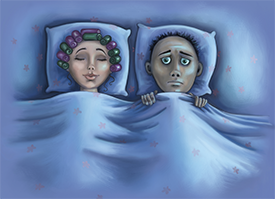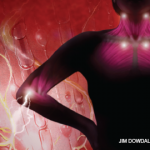
Image Credit: Kamenuka/SHUTTERSTOCK.COM
Chronic insomnia is a common complaint for patients with rheumatic diseases and conditions. In fact, sleep disturbances are among the most common symptoms of both fibromyalgia and rheumatoid arthritis (RA), with more than 50% of chronic pain patients reporting sleep disturbances.
Pain combined with insomnia can lead to a vicious cycle, says Ruth Gentry, PhD, a licensed clinical psychologist in Reno, Nev., who specializes in cognitive-behavior therapy for chronic pain. Pain makes sleep more difficult, and sleep deprivation can exacerbate pain.
New Studies Highlight Risk of Sleeping Pills
In their quest for a good night’s sleep, it’s not uncommon for patients to turn to over-the-counter sleeping pills. In addition, diphenhydramine, better known as Benadryl, has long been prescribed in skilled nursing facilities and hospitals as a sleep aid. However, a new study offers compelling evidence of a link between dementia and long-term anticholinergic medications, such as diphenhydramine, and nonprescription sleep aids.1 In addition, a 2014 study found that older adults who use benzodiazepines (e.g., alprazolam, diazepam, lorazepam) to reduce anxiety or induce sleep are at a greater risk of developing Alzheimer’s disease.2
Evidence also links the popular sleep medication Ambien to confusion in older adults and an increased risk of falls. Another study found the rate of falls increased nearly six times among patients taking the hypnotic, zolpidem (Ambien). The study also noted that zolpidem is the most commonly prescribed hypnotic sleep aid at many hospitals and encourages doctors to consider nonpharmacologic sleep enhancements.3
Addressing Insomnia as Part of a Treatment Plan
An interview with Michael Smith, PhD, of the Johns Hopkins Behavioral Sleep Medicine Program in Baltimore, published on the Lupus Foundation’s website, reports that 50–60% of people with lupus and other chronically painful conditions experience sleep deficit. In addition, Dr. Smith says lack of sleep compromises the immune system, interferes with cognition and increases symptoms of lupus, such as pain, inflammation and fatigue. He says chronic insomnia shouldn’t be ignored, but rather addressed by doctors as part of an overall treatment plan.
“Rheumatologists know poorly controlled pain can often cause difficulty sleeping, but they often don’t think about the patient having a separate sleep disorder that might be fueling the pain,” says Terry Cralle, RN, MS, CPHQ, a certified sleep specialist and co-founder of a sleep disorders clinic in Charlottesville, Va.
For this reason, Ms. Cralle says it’s important for rheumatologists to refer their patients with chronic pain for a sleep evaluation to determine if there is an underlying cause, such as sleep apnea or restless leg syndrome. The Stanford Center for Sleep Sciences and Medicine in Redwood City, Calif., notes that there are over 100 types of sleep disorders ranging from difficulty sleeping at night to problems with excessive daytime sleeplessness.
“The diagnosis and treatment of these disorders can make a huge impact on sleep and, as a result, quality of life,” Ms. Cralle says.
Because rheumatologists have limited time with their patients, Ms. Cralle recommends they work with a sleep specialist to address any ongoing insomnia issues that their patients may be experiencing.
“We can help rheumatologists determine if the patient’s lack of sleep is causing pain or if pain is causing a lack of sleep and then work to treat whichever came first,” Ms. Cralle says.
The good news is that reduction in sleep disturbance is usually followed by improvement in pain symptoms. Ms. Cralle says that when rheumatologists refer their patients with insomnia to a sleep specialist, they can help them break the cycle of chronic pain and insomnia.
“As chronic pain develops, it’s not unusual for patients to develop bad sleep habits without even realizing it,” Ms. Cralle says. “These can include staying in bed most of the day, and even taking naps throughout the day.”
Ms. Cralle says a sleep specialist can help patients beat insomnia by:
- Inquiring about their sleeping conditions: “Firmer mattresses are not always the best option for patients with chronic pain,” Ms. Cralle says. “A softer mattress or pillow top can still be supportive, yet provide softness for greater comfort for painful joints. Adjustable air beds (adjustable bases and adjustable comfort levels) can also help ease pain, help with getting in and out of bed and allow for different sleep positions for fluctuating pain levels.”
- Reviewing common medications that can disturb sleep: “For those with chronic pain and sleep problems, it’s important to ascertain that their analgesic doesn’t contain caffeine (e.g., Excedrin),” Ms. Cralle says. “In addition, many medications used to treat arthritis (e.g., prednisone) may actively disrupt sleep and should be taken in the morning rather than at night.”
Determining the Causes of Insomnia
“Any patient who complains of both pain and insomnia should have a thorough evaluation by a sleep expert,” Ms. Cralle says. “Don’t just assume the sleep problem is caused by their arthritis or autoimmune disease. There may be an unrelated disorder that is the primary culprit in the sleep disturbance, such as sleep apnea, restless legs syndrome (RLS), depression or anxiety.”
Ms. Cralle adds that RA patients have a higher incidence of RLS than the non-RA population.
“Treatment of RLS may not seem obvious if one is focused exclusively on the pain,” Ms. Cralle says. “For example, checking ferritin levels or the use of dopamine agonists may not be a standard treatment for RA, but could lead to sleep improvement.”
Sleep apnea also disproportionately affects many patients with chronic pain. In fact, Ms. Cralle says a particular variant of sleep apnea called upper airway resistance syndrome is very common in women with fibromyalgia, and the incidence of RLS has been found to affect 46–80% of patients with fibromyalgia. Diagnosing and treating the sleep disorder has been shown to improve both fatigue and pain in fibromyalgia patients.
To obtain a diagnosis of sleep apnea, Ms. Cralle says patients are given a test called a polysomnogram. Once traditionally offered only in sleep labs, there are now devices that allow patients to test for sleep apnea in the comfort of their own homes.
If a patient is diagnosed with sleep apnea, they are often prescribed continuous positive airway pressure (CPAP) therapy. CPAP patients sleep wearing a small mask that covers the nose and/or mouth and is connected to a shoebox-size machine by a flexible tube. Gentle air pressure continuously flows through the tube, holding the airway open and allowing patients to breathe normally.
Although CPAP is a highly effective treatment, some patients have problems adjusting to sleeping with the CPAP mask.
“Cognitive-behavior treatments have been found to be the most effective way to improve CPAP use and reduce CPAP discontinuation,” Dr. Gentry says.
Nonpharmacologic Treatments for Insomnia
If a sleep study shows that a patient doesn’t have sleep apnea, there is still a lot that can be done to address their insomnia, says Dr. Gentry, who receives many physician referrals for patients suffering from long-term insomnia.
At her offices in Reno, Dr. Gentry uses cognitive-behavior therapy for insomnia (CBT-I) to treat insomnia, a technique the American Academy of Sleep Medicine and the National Institutes of Health recommend as the standard treatment for insomnia. CBT-I, she notes, is different from regular cognitive-behavior therapy, which doesn’t always work for insomnia. However, CBT-I has proved effective in treating patients with comorbid health problems, chronic pain and depression.
Rheumatologists making referrals to sleep specialists should ensure that specialist has been trained in CBT-I. The American Board of Sleep Medicine has a list of specialists trained in this area, as does the Society for Behavioral Sleep Medicine.
A new study offers compelling evidence of a link between dementia & long-term anticholinergic medications, such as diphenhydramine, & nonprescription sleep aids.
“While sleep medications and antidepressants are commonly used for treatment of insomnia, sleep problems can continue to persist,” Dr. Gentry says. “Typically, it takes three to five sessions with a sleep specialist trained in CBT-I to get to the root causes of a patient’s sleeplessness to effectively treat their insomnia.”
Dr. Gentry begins by assessing each patient’s sleep difficulties to decide on the best course of action. By the time they are referred to her practice, most patients, she says, have tried such techniques as sleeping medications and sleep hygiene practices with limited success.
In her practice, Dr. Gentry teaches patients CBT-I techniques that include recognizing and changing behaviors that affect their ability to sleep.
“This could include learning how to control or eliminate negative thoughts and worries that fuel insomnia,” Dr. Gentry says. “CBT-I also teaches patients to develop good sleep habits and avoid behaviors that prevent them from getting a good night’s sleep.”
She notes that the Veterans Administration (VA) Health System has launched an effort to use CBT-I with veterans that has proved effective in treating those with post-traumatic stress syndrome and insomnia.
Ms. Cralle cites a study published in Sleep, February 2015, that found treating veterans who suffer from chronic insomnia with CBT-I therapy also helped with depression.4
Dr. Gentry says the only downside of CBT-I is that it can be hard to find a psychologist outside of a large city with CBT-I experience. She says that some sleep specialists are looking into whether telehealth technology might be able to fill the void and provide remote CBT-I therapy to those with insomnia and chronic pain who live in a remote or rural area.
Last year, the VA also released CBT-I Coach, an iPhone app that users can customize with alerts that signal when it’s time to get ready for bed, when to go to sleep and when to wake up. Although it’s not a substitute for CBT-I therapy, it can be used to complement counseling sessions.
Dr. Gentry says CBT-I techniques go beyond traditional sleep hygiene tips, such as not drinking caffeine before bed and creating a bedtime routine, and include:
- Keeping a sleep diary for two weeks and recording when they go to sleep, when they wake up and how long they were awake during the night—This information can reveal clues to why the patient is having problems sleeping;
- Learning stimulus control—“The goal of stimulus therapy is to break the negative association many patients have about sleep and to help them build a healthy association between bed and sleep,” Dr. Gentry says. “For example, patients may be encouraged to get out of bed if they aren’t sleepy and to not use their bed for activities like watching TV”; and
- Sleep restriction therapy—Using this technique, patients are encouraged to reduce their time spent in bed. Because many chronic pain patients spend a large amount of time in bed, time spent in bed is reduced, leading to increased sleep deprivation. Ultimately, patients begin spending a higher proportion of their time in bed actually asleep.
“Sleep restriction therapy improves the homeostatic sleep drive and moves bedtime closer to the normal circadian sleep phase,” Ms. Cralle says. “This increases deep (N3) sleep and decreases the number and duration of awakenings. Once sleep improves, the amount of sleep time can be slowly increased, adding about one and a half to two hours of good-quality sleep.”
Relaxation training is another CBT-I technique. “A lot of people tell me they have a problem quieting their mind at night, and relaxation training, which uses mindfulness meditation and guided imagery, can help with this,” Dr. Gentry says. In fact, mindfulness meditation, a practice that calms the mind and teaches patients how to focus on the present, has been found to be effective in reducing insomnia and improving sleep quality.5
“CBT-I has been shown to provide long-lasting results that exceed those of sleeping pills,” Dr. Gentry says. “And it’s a much safer alternative that also addresses the root cause of a patient’s sleeping problems.”
Linda Childers is a health writer located in the San Francisco Bay Area of Northern California.
References
- Gray SL, Anderson ML, Dublin S, et al. Cumulative use of strong anticholinergics and incident dementia: A prospective cohort study. JAMA Intern Med. 2015 Mar 1;175(3):401–407.
- Billioti de Gage S, Moride Y, Ducruet T, et al. Benzodiazepine use and risk of Alzheimer’s disease: Case control study. BMJ. 2014 Sep 9;349:g5205.
- Kolla BP, Lovely JK, Mansukhani MP, et al. Zolpidem is independently associated with increased risk of patient falls. J Hosp Med. 2013 Jan;8(1):1–6.
- Trockel M, Karlin BE, Taylor CB, et al. Cognitive behavioral therapy for insomnia with veterans: Evaluation of effectiveness and correlates of treatment outcomes. Behav Res Ther. 2014 Feb;53:41–46.
- Black DS, O’Reilly GA, Olmstead R, et al. Mindfulness meditation and improvement in sleep quality and daytime impairment in older adults with sleep disturbances: A randomized clinical trial. JAMA Intern Med. 2015 Feb 16. doi: 10.1001/jamainternmed.2014.8081. [Epub ahead of print]


